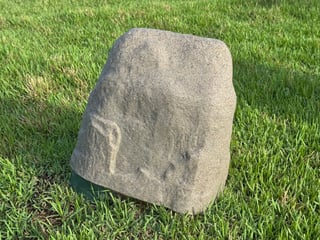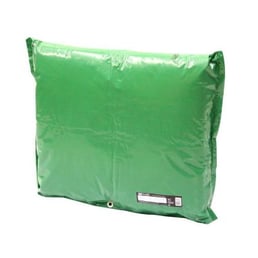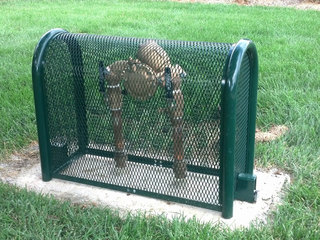A backflow enclosure may not be the flashiest part of your site design, but it plays a vital role in protecting people, property and the public water supply. More than just a metal box, a properly designed enclosure ensures your backflow preventer operates effectively no matter the season or the threats it faces.
From freezing temperatures to theft and vandalism, backflow enclosures are engineered to shield your water protection equipment while also staying compliant with plumbing codes and simplifying maintenance routines.
Let's explore what a backflow enclosure does, why it matters and how to choose one that’s built to last.
What Is a Backflow Enclosure?
A backflow enclosure is typically made of aluminum, stainless steel, or another corrosion-resistant material and designed to protect a backflow preventer from environmental exposure, unauthorized access and operational hazards.
These enclosures:
- Prevent contamination of potable water systems by keeping the backflow device functional year-round
- Ensure regulatory compliance with ASSE 1060 standards and local plumbing codes
- Allow easy access for inspection, testing and scheduled maintenance
- Extend the life of your equipment by reducing the risk of freeze, impact or tampering
Whether used in municipal waterworks or private commercial buildings, above-ground backflow enclosures are now mandated in many jurisdictions and noncompliance could result in fines, legal liability or pose a significant threat to public health.
Enclosures Protect Beyond the Basics
While enclosures are often associated with freeze protection, their value goes well beyond keeping equipment warm. Why do you need a backflow enclosure? At their core, enclosures ensure your water system continues to operate safely and effectively, no matter what conditions it faces. The right backflow enclosure:
- Provides convenient access for maintenance, inspection and testing of backflow preventer devices
- Prevents theft or vandalism, especially because the device is made of valuable materials like brass or copper
- Protects from extreme weather, including snow, high winds and rain
- Withstands high temperatures without degrading or warping, a critical factor in hot climates
Where Is the Best Place To Put a Backflow Preventer?
The best place to install a backflow preventer is outdoors, above ground, inside an ASSE 1060-certified aluminum enclosure. This setup protects the device from freezing, flooding, vandalism and environmental damage, while ensuring ready access for testing, maintenance and inspection.
Recommended installation guidelines:
- Locate near the property line but out of direct view (e.g., behind landscaping or beside the building)
- Use a properly sized aluminum enclosure certified to ASSE 1060 standards
- Mount on a concrete pad, with optional slab heating element
- Ensure adequate clearance for drainage and service access
Material Options and Considerations
Choosing the right enclosure material is essential for performance and compliance. Here's a quick breakdown followed by more detail.
|
Material |
Advantages |
Considerations |
|
Aluminum |
Lightweight, durable, corrosion-resistant even in marine environments; excellent insulation and ventilation |
Often the best balance of cost, strength and aesthetics |
|
Stainless Steel |
High durability and corrosion resistance |
Heavier and more expensive |
|
Carbon Steel |
Strong impact resistance |
May require coatings to prevent rust |
|
High-density Polyethylene (HDPE) |
Good for chemical-heavy or high-humidity environments |
May not meet code in all areas |
|
Fiberglass |
Lightweight and easy to move for regular access |
Not secure; easier to tamper with |
|
Plastic Covers |
Low cost |
Often fail to meet local building codes; easily compromised by vandals |
|
Bags or Blankets |
Frost protection for pipes |
No vandalism protection; minimal freeze protection; deteriorate quicker than other materials |
Note: In some states or municipalities, some of these structures may not be allowed due to standard details that meet both security and durability needs. Always check with your local jurisdiction and water authorities for the most up-to-date information.
Backflow Enclosures Types
Here are the common types of enclosures and what you should know about each. Often, project engineers faced with deadlines give the enclosure much less attention than the core components to the project. That's understandable, but you still have to make the right long-term solution regarding what covers those components.
This list will help you make an informed decision about your industrial enclosure. Remember: If it's worth protecting, it's worth protecting properly.
Aluminum Enclosures
 Protection: Marine grade aluminum with locking mechanism provides protection from thieves, vandals and accidents. R-9 polyisocyanurate insulation provides frost protection. A slab-mounted heater provides freeze protection to both the pipes inside the industrial shelter and the riser pipes beneath the slab.
Protection: Marine grade aluminum with locking mechanism provides protection from thieves, vandals and accidents. R-9 polyisocyanurate insulation provides frost protection. A slab-mounted heater provides freeze protection to both the pipes inside the industrial shelter and the riser pipes beneath the slab.
Sizes: almost limitless with standard models from 9" x 26" x 25" to 90" x 174" x 90" with significantly larger custom enclosures built
Colors: Typically brushed aluminum, brown, tan or green with more than 30 options available
Prices: $500-$10,000
Important to Note: The panel design used by some manufacturers makes them easy to customize everything from size and color to climate control to cutouts and additions.
Fake Rocks
Protection: Made of plastic or fiberglass, fake rock backflow covers may protect equipment from thieves due to their disguise, but lack a locking mechanism. Fake rocks rely on passive insulation and by default don't include positive means of heat (like built-in heaters) or high R-value insulation.
Sizes: Varies
Colors: Tan and brown
Price: $30 to $3,000
Key considerations: Fake rocks are typically sold with insulated bags for basic frost protection and are favored for their ability to blend into landscaping, offering discreet theft deterrence. However, their tapered design can limit interior space, so it’s important to verify dimensions carefully. They’re only suitable for backflow assemblies 2 inches and smaller.
Backflow Cages
Protection: Cages made of powder-coated steel or aluminum have no insulation to provide protection from frost or freezing conditions. They've become a theft target because their locks are easily cut to access the equipment inside.
Sizes: 24" x 24" up to 60" x 60"
Colors: Green and tan
Prices: $300 to $1,000
Key considerations: Often sold for backflow assemblies 2 inches and smaller, they're typically used in situations where temperatures don't fall below 33°F, but can be used in conjunction with an insulated bag.
Fiberglass Covers
 Protection: A fiberglass enclosure with a locking system can safeguard backflow preventer assemblies and other devices against theft, vandalism and unintentional damage. Spray foam insulation provides frost protection, and an optional wall-mounted heater can provide freeze protection to pipes inside the box.
Protection: A fiberglass enclosure with a locking system can safeguard backflow preventer assemblies and other devices against theft, vandalism and unintentional damage. Spray foam insulation provides frost protection, and an optional wall-mounted heater can provide freeze protection to pipes inside the box.
Sizes: 20" x 6.5" x 22" to 83" x 26" x 55"
Colors: Beige
Prices: $300 to $6,000
Key considerations: While fiberglass can withstand harsh conditions, it’s susceptible to UV damage that leads to fiber bloom and cracking. At larger sizes, fiberglass is often as expensive as aluminum, but lacking the same strength, durability and ease of customization. Spray foam insulation can detach during transit, and molded construction makes custom sizes and cutouts more difficult to achieve.
Plastic Enclosures
Protection: Some plastic enclosure models use insulated bags for basic frost resistance, but most don't provide true freeze protection. These enclosures lack built-in locks and are constructed from molded plastic, offering limited security against tampering or theft.
Sizes: from 34" x 16.5" x 26.5" to 48" x 16.5" x 26.5"
Colors: Green and tan
Prices: $200 to $650
Key considerations: Typically sold with an insulated bag, they're designed for backflow preventers 2" and smaller as well as pressure vacuum breakers.
Bags or Blankets
Protection: R-13 thermal insulation provides frost protection to pipes within the bag, but there's no vandalism protection.
Sizes: from 24" x 24" up to 60" x 60"
Colors: Green, blue, tan
Prices: $10 to $50
Key considerations: Typically sold together with a fake rock, cage or plastic cover for frost protection. Bags and blankets tend to deteriorate and degrade faster than other covers.
Performance Standards: What Is ASSE 1060?
ASSE 1060 is the industry standard for backflow preventer enclosures. If your enclosure doesn’t meet the standards, it may not be approved by the local authority having jurisdiction and may fail to protect the system during a critical event.
ASSE 1060 outlines essential criteria such as:
- Structural integrity (load resistance, wind/snow loads)
- Temperature control (Class I and II enclosures for freeze protection)
- Drainage requirements (to avoid water accumulation inside the enclosure)
- Access and serviceability
- Tamper resistance and locking capability
Function Meets Maintenance
Ease of maintenance is one of the most valuable — yet underrated — benefits of a quality enclosure. Unlike vaults or indoor installations, a properly designed above-ground enclosure allows for:
- Quick visual inspections
- Safe testing access through hinged panels
- Efficient repairs without confined space entry
For optimal performance, routine upkeep is essential. That includes clearing debris around the enclosure to prevent airflow blockages or pest nests; inspecting locks and hinges for corrosion or wear; and ensuring drainage grates remain clear, especially for RPZ devices, to avoid pooling water that could damage internal components.
Durability and Long-Term Value
Choosing a durable, properly insulated enclosure can minimize the need for frequent replacements, especially when exposed to temperature extremes or chemical runoff. Enclosures made from high-performance materials like marine-grade aluminum not only last longer but also resist warping, rust and UV damage.
Better durability means:
- Fewer disruptions
- Lower long-term costs
- More reliable compliance
In contrast, cheap plastic covers or cages often degrade quickly, create security risks and allow for performance issues that eventually add to your replacement budget.
Protect What Protects Your Water
Whether you’re overseeing a municipal infrastructure upgrade or planning the plumbing system for a new commercial building, a backflow enclosure isn’t a box you want to skimp on.
When specified and maintained properly, backflow enclosures:
- Prevent contamination and code violations
- Improve system reliability
- Ensure safe, efficient maintenance
- Reduce liability and equipment failure
- Comply with ASSE 1060 and state and local plumbing codes
Check out Safe-T-Cover's sizing guide to explore standard enclosures and custom solutions that combine durability, security and seamless access for testing and maintenance.
</h2





